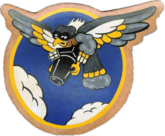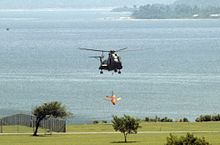1st Test and Evaluation Squadron
| 1st Test and Evaluation Squadron | |
|---|---|
 Squadron emblem | |
| Active | 1940–1947; 1969–1991; 2003–2019; 2021-present |
| Country | |
| Branch | |
| Role | Test space command and control |
| Part of | Space Delta 12 |
| Garrison/HQ | Schriever Space Force Base, Colorado |
| Motto(s) | Totem in eo est... On this, all depends |
| Engagements | European-African-Middle East Theater Asiatic-Pacific Theater[1] |
| Decorations | Air Force Outstanding Unit Award[1] |
| Commanders | |
| Current commander | Lt Col Ross Conrad |
| Insignia | |
| 1st Air and Space Test Squadron emblem |  |
| 1st Photographic Squadron emblem (approved 3 October 1941)[2] |  |
The 1st Test and Evaluation Squadron (1 TES) is a United States Space Force test and evaluation unit, located at Schriever Space Force Base, Colorado. The squadron is tasked with testing and evaluation command and control systems for Space Operations Command.
1 TES was activated on 27 August 2021 and assigned to Space Delta 12, Space Training and Readiness Command.
Mission[]
Evaluate relevant command and control systems and plans for Space Operations Command, integrating continuously improving Joint combat capability to space warfighters and commanders.
History[]
Space Launch Test[]
The 1st Air and Space Test Squadron was a unit of the 30th Space Wing of the United States Air Force, responsible for spacelift and test operations.
The squadron's operations included launching of the Minotaur I and Minotaur IV and Pegasus rockets; as well as testing the Boeing Interceptor and Minotaur II target vehicles.[3]
The squadron's mission was to provide complete service launch and test operations for current and future space launch vehicles, targets, interceptors and experimental space systems.
World War II[]
The squadron was established by Headquarters, United States Army Air Corps in early 1940 as the 1st Photographic Squadron.[2] It performed aerial mapping primarily over the northeastern United States prior to the Pearl Harbor Attack using obsolescent cargo and Martin B-10 bombers. After the United States entry into World War II, equipped with Lockheed A-29 Hudsons, Beech C-45 Expeditors and Douglas A-20 Havocs (all in photographic reconnaissance configuration) and performed aerial photography and mapping over uncharted areas of Newfoundland, Labrador and Greenland for development of the Northeast Transport Route for the movement of aircraft, personnel and supplies across the North Atlantic from the United States to Iceland and the United Kingdom.
The squadron re-equipped with long-range Consolidated B-24 Liberator reconnaissance aircraft and deployed to Alaska in late 1943, assisting in the establishment of landing fields in the Aleutian Islands; also to map uncharted areas of internal Alaska to establish Lend Lease aircraft emergency landing fields over trans-Alaska route from Ladd Field and Elmendorf Field to Nome.

The squadron was relieved from assignment in Alaska and returned to the Continental United States. It deployed to the Mediterranean Theater of Operations across the South Atlantic Transport Route to North Africa in early 1944. It performed aerial surveys and mapping over Sicily; Italy and along the North African Coast and Middle East with B-24s and some Boeing B-17Fs converted to F-9 reconnaissance configuration over non-combat areas. It then deployed to India and China; performing unarmed long-range mapping of remote areas of the China-Burma-India Theater over combat areas in support of ground forces and strategic target identification over Indochina and the Malay Peninsula for follow-up raids by XX Bomber Command operating from India.
The unit returned to the United States in late 1944. It was equipped with very long range Boeing B-29 Superfortresses converted to F-13A reconnaissance configuration. It deployed to the Central Pacific Area after the Surrender of Japan and was assigned to the Eighth Air Force. The squadron performed reconnaissance mapping flights over Japan, Korea and China. The B-29s returned to the United States in early 1946 for storage or reassignment; unit largely demobilized on Okinawa, flying some light liaison and courier aircraft. It was inactivated in early 1947 and disbanded on 8 October 1948.[2]
Test Operations in the Pacific[]

This section does not cite any sources. (December 2012) |
The squadron replaced the 6400th Test Squadron, which had been organized in 1967, in 1969. It conducted weapons system evaluation, known as COMBAT SAGE, of F-4 aircraft, of F-15 aircraft from 1980, and of F-16 aircraft from 1982, until shortly before inactivation. It also trained visiting aircrews from other Pacific Air Forces units in weapons employment and tactics.
Lineage[]
- 1st Photographic Squadron
- Constituted as the 1st Photographic Squadron on 22 December 1939
- Activated on 1 February 1940
- Redesignated 1st Mapping Squadron on 13 January 1942
- Redesignated 1st Photographic Mapping Squadron on 9 June 1942
- Redesignated 1st Photographic Charting Squadron on 11 August 1943
- Redesignated 1st Photographic Reconnaissance Squadron, Very Heavy on 10 November 1944
- Redesignated 1st Reconnaissance Squadron, Very Long Range, Photographic-RCM[note 1] on 4 October 1945
- Redesignated 1st Reconnaissance Squadron, Very Long Range, Photographic on 13 November 1945
- Inactivated on 10 March 1947
- Disbanded on 8 October 1948
- Reconstituted and consolidated with the 1st Test Squadron as the 1st Test Squadron on 19 September 1985[1]
- 1st Test Squadron
- Constituted as the 1st Test Squadron on 12 September 1969
- Activated on 15 October 1969
- Consolidated with the 1st Reconnaissance Squadron on 19 September 1985
- Inactivated on 30 October 1991
- Redesignated 1st Air and Space Test Squadron on 28 October 2003
- 1st Test and Evaluation Squadron
- Activated on 27 August 2021
Assignments[]
- Office of Chief of Air Corps, 1 February 1940
- 1st Photographic Group (later 1st Mapping Group, 1st Photographic Charting Group), 10 June 1941
- 11th Photographic Group, 1 December 1943
- 311th Photographic Wing, 5 October 1944
- Second Air Force, 10 November 1944 (attached to Eighth Air Force, c. 9 September 1945)
- 311th Reconnaissance Wing, 4 October 1945 (attached to United States Army Strategic Air Forces (Pacific) 4 October 1945, Far East Air Forces 21 November 1945, VII Bomber Command 10 December 1945, Eighth Air Force March 1946, 1st Air Division 7 June 1946
- Far East Air Forces, 3 February 1947
- Thirteenth Air Force, 11 February 1947 - 10 March 1947 (attached to 5th Reconnaissance Group)
- 6th Air Division, 15 October 1969
- Thirteenth Air Force 15 December 1969
- 405th Fighter Wing, 20 April 1970
- 3d Tactical Fighter Wing, 16 September 1974
- 6200d Tactical Fighter Training Group, 1 January 1980 - 30 October 1991
- 30th Launch Group, 1 December 2003 – 15 Aug 2019[1]
- Space Delta 12, 27 August 2021 – present
Stations[]
- Bolling Field, District of Columbia, 1 February 1940
- Bradley Field, Connecticut, 5 December 1941
- MacDill Field, Florida, 15 January 1944 (deployed to Accra Airfield, Gold Coast, British West Africa, 11 March 1944 - 13 October 1944)
- Smoky Hill Army Air Field, Kansas, 26 October 1944 - 31 July 1945
- Kadena Field, Okinawa, 9 September 1945
- Clark Field, Philippines, 11 February 1947 - 10 March 1947
- Clark Air Base, Philippines, 15 October 1969 - 30 October 1991
- Vandenberg Air Force Base, California, 1 December 2003 – 15 Aug 2019[1]
- Schriever Space Force Base, Colorado, 27 August 2021 – present
Aircraft[]
- Douglas A-20 Havoc, 1942
- Lockheed A-29 Hudson, 1941-1942
- Martin B-10, 1940
- Boeing B-17 Flying Fortress, 1943-1944
- Consolidated B-24 Liberator, 1942-1945
- North American B-25 Mitchell, 1943
- Boeing B-29 Superfortress, 1944-1947
- Lockheed B-34, 1942-1945
- Fairchild C-8, 1940
- Beech C-45 Expeditor, 1940, 1946-1947
- Beech F-2 (see C-45)
- Douglas F-3 (see A-20)
- Consolidated F-7 (see B-24)
- Boeing F-9 (see B-17)
- Boeing F-13 (see B-29)
- Piper L-4, 1946
- Stinson L-5 Sentinel 1946-1947
- McDonnell Douglas F-4 Phantom II, 1969-unkn (at least until 1989)
- McDonnell Douglas F-15 Eagle, 1980-unkn (at least until 1989)
- General Dynamics F-16 Fighting Falcon, 1982-unkn (at least until 1989)
- Ryan BQM-34A Firebee, 1969-1989
- Raytheon MQM-107 Streaker, 1989-unkn.
Decorations[]

- Air Force Outstanding Unit Award
- 3 April 1975 – 31 May 31, 1975
- 1 July 1976 – 30 June 30, 1977
- 1 April 1980 – 31 March 1982
- 1 July 1985 – 30 June 30, 1987
- 1 June 1988 – 1 June 1990

- Philippine Republic Presidential Unit Citation
- 21 July 1972 – 15 August 1972[5]

- American Theater of World War II

- European Theater of World War II
- Pacific Theater
List of commanders[]
This list is incomplete; you can help by . (September 2021) |
- Lt Col Ross Conrad, 27 August 2021[6]
References[]
Notes[]
- Explanatory notes
- ^ RCM (Radio Countermeasures) would later be more commonly referred to as electronic countermeasures.
- Citations
- ^ Jump up to: a b c d e f Warnock, A. Timothy (January 2, 2008). "Factsheet 1 Air and Space Test Squadron (AFSPC)". Air Force Historical Research Agency. Retrieved July 12, 2018.
- ^ Jump up to: a b c Maurer, Combat Squadrons, pp. 8-9
- ^ Vandenberg AFB Fact Sheet: 1st Air and Space Test Squadron Archived 2008-05-03 at the Wayback Machine, 1 March 2010 (retrieved Dec 16, 2012)
- ^ "2nd SLS reactivated following squadron merger". Vandenberg Space Force Base. Retrieved 2021-08-29.
- ^ AF Pamphlet 900-2, Vol II, p. 4
- ^ "Space Delta 12 recognition ceremony". Schriever Space Force Base.
 This article incorporates text from this source, which is in the public domain.
This article incorporates text from this source, which is in the public domain.
Bibliography[]
![]() This article incorporates public domain material from the Air Force Historical Research Agency website http://www.afhra.af.mil/.
This article incorporates public domain material from the Air Force Historical Research Agency website http://www.afhra.af.mil/.
- Maurer, Maurer, ed. (1983) [1961]. Air Force Combat Units of World War II (PDF) (reprint ed.). Washington, DC: Office of Air Force History. ISBN 0-912799-02-1. LCCN 61060979.
- Maurer, Maurer, ed. (1982) [1969]. Combat Squadrons of the Air Force, World War II (PDF) (reprint ed.). Washington, DC: Office of Air Force History. ISBN 0-405-12194-6. LCCN 70605402. OCLC 72556.
- AF Pamphlet 900-2, Unit Decorations, Awards and Campaign Participation Credits, Vol II Department of the Air Force, Washington, DC, 30 Sep 76
- Space squadrons of the United States Air Force
- Test squadrons of the United States Air Force
- Military units and formations established in 1969
- Military units and formations disestablished in 2019
- Military units and formations in California



